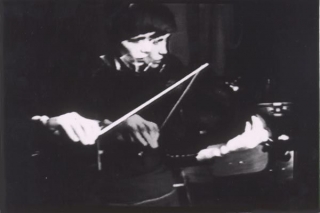Vasulka Video: Performance
Date: 6 March 2004 | Season: Vasulka Video
VASULKA VIDEO: PERFORMANCE
Saturday 6 March 2004, at 7:30pm
London University of Westminster
Steina presents a live adaptation of her seminal tape Violin Power, using MIDI violin and customised software to process the video image in real time. Plus a screening of Orbital Obsessions, a multi-layered studio performance/exploration of reshaped video space.
Steina, Violin Power: The Performance, 1992-present
Steina, Violin Power, 1970-78, b/w, sound, 10 mins
Steina, Orbital Obsessions, 1975-77/78, b/w, sound, 25 mins
VASULKA VIDEO: PERFORMANCE
Saturday 6 March 2004, at 7:30pm
London University of Westminster
VIOLIN POWER: THE PERFORMANCE
Steina, 1992-present, live performance
“In 1991, after having experimentally interfaced my acoustic violin with a variable speed video cassette player, I bought a MIDI violin and a Pioneer Disk Player. Interfacing these instruments with a computer gave me an instant access to any frame of video on the disk as well as access to fast/slow and forward/backward movements. The initial software was written by Russ Gritzo and further developed and improved by Bill Heckel. Violin Power is a ongoing continuous project with an ever increasing ‘repertoire.’ So far I have made five videodisks and I change the program for every performance.” (Steina)
The ZETA Violin is a five-stringed electric violin with a MIDI output. The assignment, at the moment, is that stops on A and E string point to frame locations on the disk. The D and G strings control speed and direction and the C string is a master controller assigned to address segments on the disks. In another programming scheme, the C string controls which upper strings get assigned their function, as Steina experiments to make the performance more musically interesting.
“Steina’s project of manipulating and fusing the “real” and the electronic, sound and image, has in recent years taken the form of performances in which she returns to her roots as a musician. Transposing the strategies of her early Violin Power to a theatrical scale, Steina performs on a violin that digitally generates and controls a progression of projected images.” (Mondavi Arts Center)
VIOLIN POWER
Steina, 1970-78, b/w, sound, 10 mins
The first excerpt investigates the impact of varying pitches on the speed of the image. Steina’s body is invaded by a sort of double-exposure that quivers like the vibrato produced by a violin bow. In another sequence, Steina adds further components to an already complex interface. The sound modulations of the violin cause the viewpoints of two parallel cameras to alternate. Steina is first seen from behind, and then the bow’s movement seems to deflect the signal and a keyed-in image of Steina from the front appears. This effect is generated by the combined use of a keyer and an audio synthesiser (Harald Bode’s Phase Shifter) in closed circuit with the two cameras. Other excerpts feature effects generated by the Scan Processor developed by Steve Rutt and Bill Etra. The sound waves seem to cause ripples in the image’s surface, while the bow’s friction on the strings results in textured visual effects that evoke the violin’s timbre. Finally, the representation of the performing musician, the sounds produced, and the modulations in the video signal converge into a single luminous entity. The Vasulkas are deeply intrigued by the interface between audiotape and videotape; indeed, this interface is the focus of such pieces as Noisefields (1974) and Voice Windows (1986). Violin Power adds an additional dimension to this dialectic research by simultaneously showing the gestation of images, their mediation by instruments (violins, synthesizers), and the moment when these images crystallise on the monitor.
ORBITAL OBSESSIONS
Steinal, 1975-77/78, b/w, sound, 25 mins
Orbital Obsessions includes excerpts from Signifying Nothing (1975), Sound and Fury (1975), Switch! Monitor! Drift! (1976) and Snowed Tapes (1977). In these pieces, Steina focuses on time, space, and movement, and the means by which the mechanical can inform and engage with electronic media. Steina writes: “Ordinarily the camera view is associated with a human view point, paying attention to the human conditions around the camera. In this series the camera conforms to a mechanised decision-making of instruments… I am also paying attention to time accumulation, in a mix of real time with time inherited from each previous generation of pre-recorded and then re-taped segments.”
